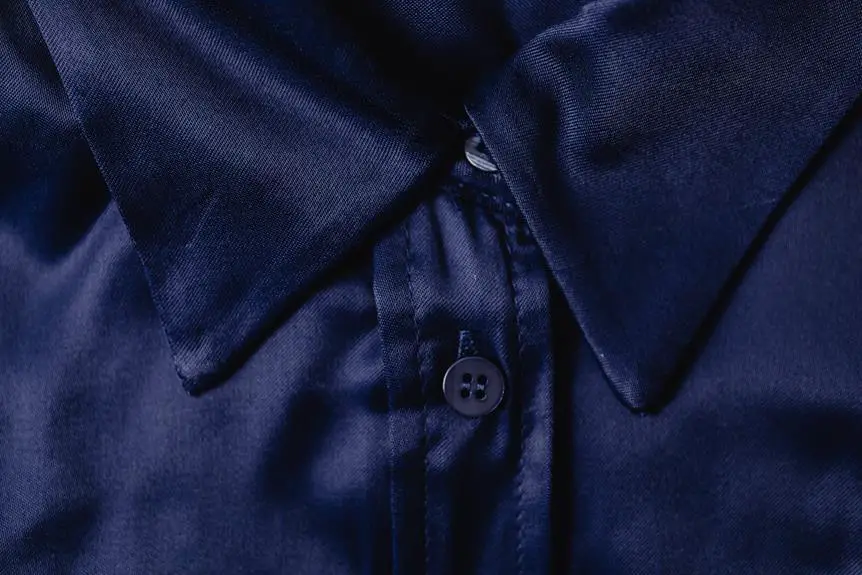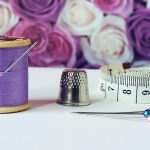If you're tired of dealing with a floppy collar, you've come to the right place. This article will show you 5 ways to fix a floppy collar using fabric tips.
These techniques are perfect for those who want to master the art of maintaining a crisp and polished look. From starching and ironing to sewing in collar stays, you'll learn how to keep your collar looking sharp and professional.
Whether you're dealing with a dress shirt, blouse, or jacket, these fabric tips will help you achieve a perfectly tailored appearance every time.
Key Takeaways
- Dilute starch with water for a light starch and use undiluted starch for a heavier starch
- Select appropriate fabric interfacing for collar reinforcement and adhere it with iron
- Sew collar stays using straight stitching, diagonal stitching, reinforced corners, and bar tack stitching for maximum stay security
- Reshape collar using steam and heat, paying attention to corners and edges, and let it cool and set in new form
Starching and Ironing Techniques
To fix a floppy collar, start by starching and ironing it to restore crispness and structure. Starching techniques vary based on the level of stiffness desired. For a light starch, dilute the starch with water according to the instructions on the product. Apply the starch to the collar, ensuring an even coating, and then let it dry completely before ironing.
For a heavier starch, use the undiluted starch and follow the same application and drying process. When ironing, set the iron to the appropriate heat setting for the fabric. Use a burst of steam while ironing to further set the starch and achieve a smooth, crisp finish. Ironing tips include using quick, steady movements and applying firm pressure to remove any wrinkles. Pay special attention to the collar points and edges to ensure they're sharp and well-defined.
Once starched and ironed, your collar will hold its shape and maintain a professional appearance throughout the day.
Collar Reinforcement With Fabric Interfacing
For an added level of collar stiffness, consider reinforcing it with fabric interfacing to ensure a long-lasting crispness and structure. Fabric interfacing is a supportive material that's applied to the underside of the collar to provide additional reinforcement. To apply interfacing, start by selecting the appropriate type based on the desired level of stiffness and the fabric of the collar.
Cut the interfacing to match the shape and size of the collar, ensuring that it covers the entire area needing support. Then, carefully adhere the interfacing to the collar fabric using an iron and following the manufacturer's guidelines. It's important to use the right amount of heat and pressure to securely bond the interfacing without damaging the collar fabric.
Once the interfacing is applied, the collar will have enhanced support and structure, preventing it from becoming floppy or losing its shape over time. By mastering the art of interfacing application, you can effectively elevate the quality and durability of your collars, ensuring a polished and professional look.
Sewing in Collar Stays
Once you have reinforced your collar with fabric interfacing, you can further improve its stability by sewing in collar stays. Collar stays are small, pointed strips, typically made from metal, plastic, or horn, that are inserted into specially made pockets on the underside of a shirt's collar to ensure it stays crisp and in place throughout the day. Here are some sewing techniques for inserting collar stays:
| Sewing Technique | Description |
|---|---|
| Straight Stitching | Sew along the edges of the collar stay pocket using a straight stitch to secure the stays. |
| Diagonal Stitching | Create a diagonal stitch pattern within the pocket to prevent the collar stay from slipping. |
| Reinforced Corners | Sew the corners of the collar stay pocket with a reinforced stitch to add extra durability. |
| Bar Tack Stitching | Use bar tack stitches at the top and bottom of the pocket opening for maximum stay security. |
Collar Reshaping With Steam and Heat
After reinforcing your collar with fabric interfacing and sewing in collar stays, you can reshape a floppy collar using steam and heat to restore its crispness and structure. Here's how to do it effectively:
- Steam Treatment: Hang your shirt in the bathroom while you take a hot shower. The steam will help relax the fibers, making the collar pliable for reshaping. Alternatively, use a handheld steamer to target the floppy areas directly.
- Heat Application: After steaming, use an iron on low heat to reshape the collar. Place a press cloth over the collar to protect the fabric. Gently press and shape the collar with the iron, paying extra attention to the corners and edges.
- Cooling and Setting: Once you've reshaped the collar, let it cool and set in its new form by laying the shirt flat for a few minutes. This step helps the fibers to retain the new shape.
DIY Collar Support Inserts
To further enhance the structure and crispness of your shirt collar, consider creating your own DIY collar support inserts using lightweight and flexible materials.
Fabric stiffeners or collar support products can be easily fashioned into inserts to provide the necessary reinforcement for your collar. One popular option is using fusible interfacing, which can be cut into strips and inserted into the collar band to provide support.
Another DIY approach is to repurpose lightweight plastic materials, such as those from detergent or milk jugs, by cutting them into collar-shaped strips and placing them inside the collar.
For a more professional touch, consider using pre-made collar support products, which are typically made of durable, bendable materials that offer long-lasting support. These products come in various shapes and sizes to accommodate different collar styles.
Frequently Asked Questions
Can I Use the Same Fabric Interfacing for Different Types of Fabric Collars?
You can use the same fabric interfacing for different types of fabric collars, but it's important to consider the weight and stiffness of the interfacing options to ensure suitability and compatibility with the fabric collar.
How Often Should I Replace Collar Stays in My Shirts?
You should replace collar stays in your shirts regularly to maintain a crisp, professional look. Professional advice recommends checking and replacing them as needed to keep your collars looking sharp.
Is It Safe to Use Steam and Heat on Delicate Fabric Collars?
When using steam on delicate fabric collars, it's important to prioritize safety. Avoid direct contact with the fabric and use a lower heat setting to prevent damage. Always test a small, inconspicuous area first to ensure it's safe.
What Kind of Fabric Should I Use for DIY Collar Support Inserts?
For DIY collar inserts, the best fabric choice is interfacing. It's a sturdy option that provides support without bulk. It's a great collar stay replacement and allows for safe reshaping with a straightener.
Can I Use a Hair Straightener to Reshape a Floppy Collar?
Yes, you can use a hair straightener to reshape a floppy collar. Be sure to use low heat and a pressing cloth to avoid damaging the fabric. For collar stiffening, try using vinegar to restore its shape.
- How Does Ring Spun Cotton Affect Garment Fit and Shape Retention? - August 13, 2024
- What Are the Challenges in Producing Ring Spun Cotton? - August 13, 2024
- Is Ring Spun Cotton Suitable for Plus-Size Clothing? - August 13, 2024





